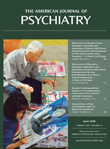Can Psychiatrists Recognize Mental Illness in Paintings?
It is widely believed that mental illness is reflected in paintings of mentally ill artists (1) . Examples include Van Gogh’s “blue” period (depression) and “pink” period (manic phase of bipolar disorder) (2) and Louis Wain’s cat paintings (progressive deterioration to complete incoherence, paralleling schizophrenia) (3) . However, when we asked 12 psychiatrists to evaluate randomly selected paintings created by individuals with 1) schizophrenia, 2) bipolar disorder, and 3) no psychiatric illness (N=10 for each), they were unable to differentiate paintings by artists with and without mental illness.

We then randomly selected paintings of four artists with known bipolar disorder (Paul Gauguin, Edward Münch, Vincent van Gogh, Mark Rothko). We asked 12 psychiatrists and 12 laypersons matched for education to determine the period of creation (before or after onset of mental illness), first for individual paintings grouped by artist and then for sets of paintings for each artist.
Psychiatrists could reliably identify paintings created before and after onset of mental illness both individually (χ 2 =31.42, df=1, p<0.001) and in sets (χ 2 =17.34, df=1, p<0.01). In contrast, laypersons were able to recognize mental illness only from sets of paintings (χ 2 =4.32, df=1, p<0.05), not from individual paintings.
The potential clinical significance of psychiatrists’ ability to recognize mental illness in paintings before and after an episode of psychiatric illness needs further study in individuals other than famous artists.
1. Anastasi A, Foley J: A survey of the literature on artistic behavior in the abnormal, IV: experimental investigations. J Gen Psychol 1941; 25:187–237Google Scholar
2. Maisel E: The Van Gogh Blues. Emmaus, Pa, Rodale Books, 2002Google Scholar
3. Dale R: Louis Wain: The Man Who Drew Cats. London, Chris Beetles, 1992Google Scholar



